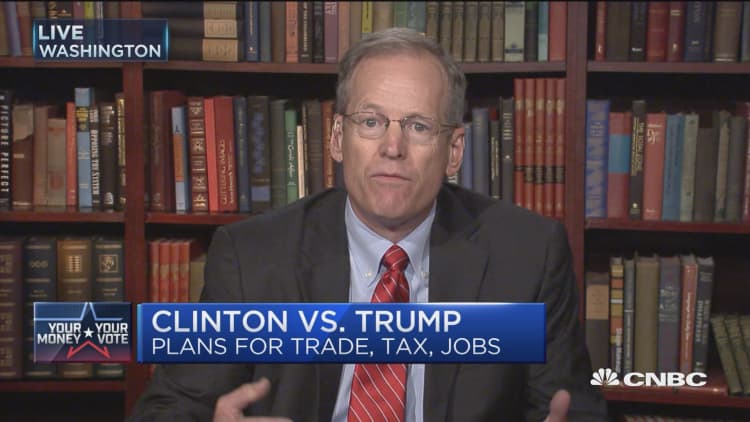
Keep an eye on the stock market between now and the presidential election: There's a very good chance investors will point the way to the winner.
In fact, since 1944 the behavior of the has been an excellent indicator of who will win the White House.
Looking specifically at this year's contest, a rising market between Aug. 1 and Oct. 31 would favor Democrat Hillary Clinton, while a decline would point to victory for Republican nominee Donald Trump in the Nov. 8 election.
That's based on an analysis of how the market performed compared to which party at that time held the Oval Office.
For instance, the indicator worked in 1948 during the race between incumbent Democrat Harry S. Truman and Republican challenger Thomas Dewey. The S&P 500 rose 4.4 percent during the period in question, correctly indicating that the party in power would retain the White House, according to data provided by Sam Stovall, U.S. equity strategist at S&P Global Market Intelligence.
One of the few times it failed was in 1968. That was during the race between Democrat Hubert H. Humphrey and Republican Richard M. Nixon. The index rallied a healthy 3.9 percent in the August-to-October period, but Humphrey failed to take the baton from Lyndon B. Johnson and hold onto the presidency.
In all, the market has predicted the winner by party of 15 of the last 18 elections — an 83 percent success rate. The chart below shows how the pattern has played out over time. (The winner is in capital letters, while (i) denotes the incumbent party.)
The market's crystal ball
| Year | Democrat | Republican | S&P 500 % return (Oct.-Nov.) | Correct party indicator? |
|---|---|---|---|---|
| 1944 | ROOSEVELT (i) | Dewey | 0.6 | Yes |
| 1948 | TRUMAN (i) | Dewey | 4.4 | Yes |
| 1952 | Stevenson (i) | EISENHOWER | -3.5 | Yes |
| 1956 | Stevenson | EISENHOWER (i) | -7.7 | No |
| 1960 | KENNEDY | Nixon (i) | -3.8 | Yes |
| 1964 | JOHNSON (i) | Goldwater | 2 | Yes |
| 1968 | Humphrey (i) | NIXON | 5.8 | No |
| 1972 | McGovern | NIXON (i) | 3.9 | Yes |
| 1976 | CARTER | Ford (i) | -0.5 | Yes |
| 1980 | Carter (i) | REAGAN | 4.8 | No |
| 1984 | Mondale | REAGAN (i) | 10.2 | Yes |
| 1988 | Dukakis | BUSH (i) | 2.6 | Yes |
| 1992 | CLINTON | Bush (i) | -1.3 | Yes |
| 1996 | CLINTON (i) | Dole | 10.2 | Yes |
| 2000 | Gore (i) | BUSH | -0.1 | Yes |
| 2004 | Kerry | BUSH (i) | 2.6 | Yes |
| 2008 | OBAMA | McCain (i) | -23.6 | Yes |
| 2012 | OBAMA (i) | Romney | 2.4 | Yes |
Source: Source: S&P Global Market Intelligence
While some of these indicators can be fairly coincidental rather than causative, this one is pretty intuitive. A rising market generally is indicative of a broader upbeat sentiment. Voters are thus more reticent to make change. The S&P 500 is up about 0.4 percent in August, though it was down fractionally Friday.
"We all love to say the market hates uncertainty. If the market is going up the implication is that the market believes that there will not be uncertainty through the change of platform," Stovall said in a phone interview. "Hillary has said 'I plan to maintain the Obama platform,' so she is much more of a known quantity."
Of course, investors also could be buying in anticipation of a Trump presidency that would revert much of Obama's policies. But the current polling numbers don't support that thesis.
Fresh results from NBC News/Wall Street Journal/Marist polls show Clinton building substantial leads in the key battleground states of Colorado, Virginia, North Carolina and Florida. The Real Clear Politics national average puts Clinton's lead at 6.3 points.
Another reason the market may have some momentum — up 1.4 percent over the past month and 4 percent since July 1 — is that investors simply aren't banking on many major changes from either candidate in the most important area: monetary policy.
If Clinton is intent on building on the Obama agenda, then she's unlikely to appoint Federal Reserve members who would want to raise interest rates. And Trump has been explicit: He plans on funding his ambitious infrastructure and military buildup with generous levels of debt dependent on a dovish central bank.
The Fed has raised rates just once over the past 10 years and isn't expected to enact another hike until at least mid-2017. Historically, easy monetary policy has coincided with a 225 percent bull market run over the past 7 ½ years, meaning that the prospect of a continued low-rate environment is causing optimism regardless of who wins.



